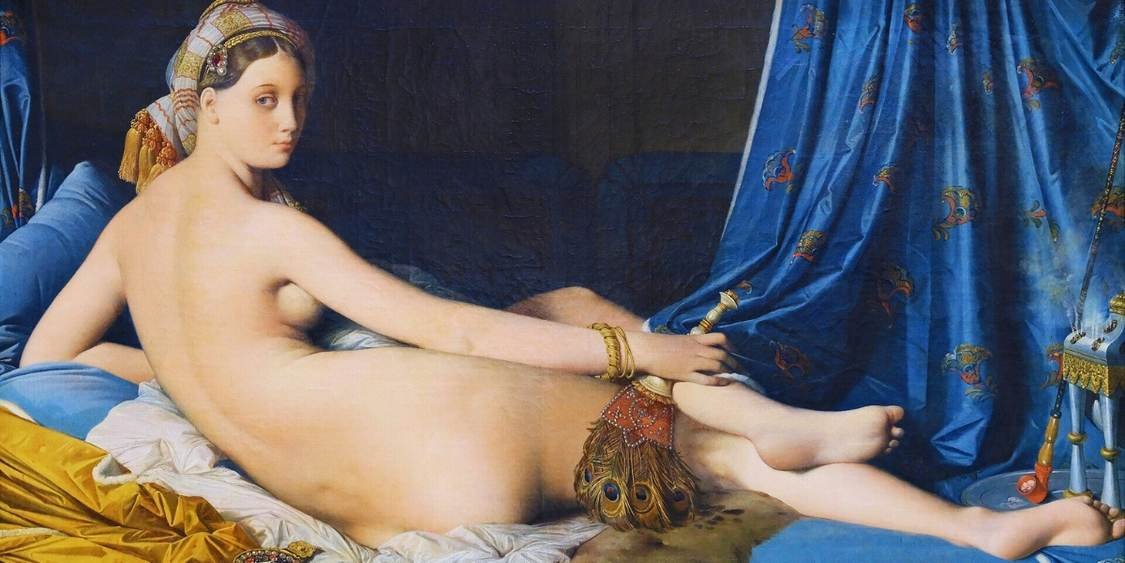Paris, Musée du Louvre
Ingres, the most important representative of 19th-century official French art and a protégé of Napoleon I, had no problem with distorting bodies to preserve what he considered the beauty of the line. Which is exactly what he did in this painting of a harem girl, which was ridiculed when first exhibited in Paris at the Salon of 1819; salon goers complained that her sinuous back had too many vertebrae and her oddly elongated arm had no elbow.
But this idealism to the point of deformity, that placed the goal of a graceful composition above all else, did not bother Ingres. A neo-classicist with a penchant for Romanticism, Ingres fully believed in the principals of academic ‘official’ art that sought to depict the ideal, purging the imperfections of reality and individuality from art. After winning the Prix de Rome (a prestigious scholarship awarded by the French Academy) Ingres went to study in Italy where he stayed for 18 years, living the often-impoverished life of the romantic artist. There he studied medieval, Renaissance and Byzantine art, developed a love of the smooth surfaces of Raphael and a taste for the exotic.
It was while in Italy that he painted La Grand Odalisque, for Caroline Murat, Napoleon’s sister and Queen of Naples. It depicts a young Turkish concubine and is one of the first examples in art of ‘Orientalism’ – a term referring to the West’s fascination with the Muslim world of North Africa and the Near East. This fascination began with Napoleon’s Egyptian campaign of 1798–99, which disseminated information and images about Egypt throughout Europe and soon changed fashion and tastes. Ingres’ painting was a part of this Orientalist zeitgeist: Byron’s poem about a harem girl, ‘The Corsair’ was published the same year.
The exotic subject gave Ingres license to paint an alluring nude who was not a classical goddess. However the young concubine is more informed by western art history than by an actual harem. Her pose recalls many Renaissance and Baroque paintings of reclining Venuses and her face and hairstyle are European. Despite her languid sensuality and the inclusion of the hashish pipe, incense burner, bejewelled fan and turban, there is a sense of refinement, a cultivated idealism to the point of classicism.
The painting reflects Ingres’ preference for tight brushwork and icy hard surfaces to painterly drama or gesture. Ingres was a master colourist and the gem-like blues and golds brilliantly contrast with the woman’s pale skin, which looks as silky as the lush fabrics on which she lounges. And despite her unusual proportions, she is beautiful, an iconic image of the West’s erotic dream of the East.
It was only when Ingres returned to Paris in 1824, that he found critical success. When this work, which had raised such scorn in 1819, was exhibited again in 1846 and 1855, it was lavished with praise. It is now recognised as central to Ingres’ conception of ideal beauty, though this was a beauty not shared by all: Delacroix, the leader of the French Romanticists and Ingres’ chief rival, called Ingres’ art ‘the perfect expression of an imperfect intellect’. (However, Ingres gave as good as he got and called Delacroix the leader of the ‘school of ugliness’.)
Contemporary Works
1814 Francisco de Goya: Third of May 1808, Madrid, Museo Nacional del Prado
1814 Théodore Géricault: The Wounded Cuirassier, Paris, Musée du Louvre
1815 J.M.W. Turner: Dido Building Carthage, London, National Gallery
Categories:
- French Nineteenth Century Painting
- Neoclassicism

